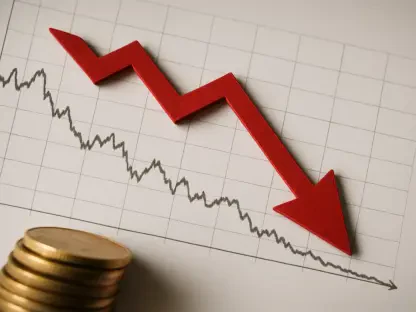The recent agreement between the United States and China to implement mutual tariff reductions has ushered in a significant turning point in global trade relations. This decision has sparked a wave of optimism across financial markets, particularly rejuvenating interest in equities and technology sectors. As the two largest economies scale back on the trade barriers that once strained international business activities, there is an evident shift in market dynamics. The ripple effect extends beyond financial markets, also influencing commodity demand and sector-specific sentiments, showcasing broad-spectrum industrial ramifications.
Market Dynamics and Investor Sentiment
Stock Market Surge
The agreement, highlighting a reduction in the tariffs imposed by the US on Chinese imports and vice versa, catalyzed a remarkable increase in stock market indices. This surge was particularly prominent in major US indices, including the Dow Jones, S&P 500, and Nasdaq, which marked significant gains. Investors interpreted this development as a reduction in geopolitical tensions, contributing to an evident resurgence of confidence in the markets. However, it is crucial to appreciate that this optimism is tempered by an awareness of the agreement’s temporary status. Given its ninety-day term, investors remain cautiously optimistic, knowing that the true long-term impact depends on subsequent negotiations and policy adjustments. Despite the short-term nature of the agreement, the current spike underscores how sensitive market sentiments are to diplomatic progress, highlighting resilience and volatility in equal measure.
Focus on Technology Stocks
Central to this market upswing has been the focus on technology stocks, which have proven to be significant beneficiaries of reduced trade tensions. Leading companies such as Apple, Amazon, and Nvidia experienced notable stock price increases as investors viewed the tariff cuts as a potential stabilizing force for global supply chains. The previous trade barriers had cast shadows of uncertainty over these companies due to their deep entrenchment in the global marketplace, but the current developments have reversed the tide. The increase in technology stock valuations reflects not just an immediate investor reaction but also a broader expectation of recovery from past disruptions. This stability encourages further investment and highlights the potential for sustained growth and innovation. The rapid influx of capital into these stocks is indicative of the wider market sentiment that hopes to see a smoother operating environment for technological giants.
Sector Impacts and Divergence
Technology Sector Gains
The relief among tech giants underscores the wider recognition of their critical role in the global economy, particularly amid the current geopolitical climate. By easing tariff inhibitions, the market anticipates not just recovery but potential expansion that could redefine the tech landscape. The confidence in these tech firms has been reflected in their stock performance, with the potential for renewed innovation as supply chains stabilize. As such, the enthusiasm extends beyond traditional equity markets to include venture investments, partnerships, and technological developments sparking optimism for technological advancements and growth. Nevertheless, the optimism within the technology sector contrasts sharply with some waning sectors, highlighting divergent impacts across the market landscape. Comparing these outcomes offers insights into the nuanced reactions markets have in response to geopolitical shifts.
Pharmaceutical Sector Pressures
While tech stocks have thrived, the pharmaceutical sector has witnessed pressures that dampened investor sentiment. This reaction largely stems from recent US policy shifts aimed at significantly reducing prescription drug prices, which have sparked concerns over profit margins. The anticipated regulatory changes have triggered a dip in share prices across American, European, and Asian pharmaceutical companies, showing the interconnectedness of global pharmaceuticals. The impact of reduced profits could lead to strategic overhauls in an industry already grappling with stringent regulations and competitive pressures. As a result, while tariff reductions appear to have provided temporary respite in broader markets, the pharmaceutical industry exemplifies sector-specific stresses, indicating the complex balance of benefits and challenges brought about by changing policies.
Commodity Markets and Economic Indicators
Robust Commodity Demand
In the wake of tariff cuts, the commodities market experienced a noticeable shift with increased demand, particularly for oil and metals such as copper and iron ore. This rise in demand has spurred price increases, reflecting the market’s anticipation of diminished economic fallout and revived industrial activities. As nations hope for an easing of the geopolitical strains, the resultant decreased uncertainty revitalizes demand for raw materials. This trend highlights how sensitive commodity markets are to geopolitical developments, as fluctuating investor sentiment often dictates supply and demand dynamics. This sensitivity, however, has led to a decline in gold prices, typically seen as a safe haven asset. Investors, buoyed by optimistic prospects, are thus shifting focus toward riskier yet potentially more profitable avenues.
Upcoming Economic Data
Amid these market adjustments, anticipation for upcoming economic data releases remains high. Indicators such as the Consumer Price Index (CPI) and the Producer Price Index (PPI) are pivotal in assessing inflationary pressures that may stem from shifting trade policies. Such data provide valuable insights into how these tariff reductions might impact prices across various sectors. Analysts and investors closely watch these figures, alongside the earnings reports from influential corporations, to gauge broader economic trends. For businesses like Sony, Fox, and Walmart, these outcomes will shape strategic decisions and potential market adaptations. This careful analysis is critical in navigating the uncertain landscape, guiding investors and policy-makers in making informed decisions reflective of current market conditions.
Long-Term Outlook and Analysis
Temporary Nature of Tariff Reductions
While the current tariff reduction agreement brings immediate relief, its inherently temporary nature necessitates careful observation of subsequent negotiations and policy shifts. Analysts argue that sustained market stability hinges on the agility of diplomatic engagements beyond the agreement’s ninety-day scope. There remains a recognition that the evolving geopolitical landscape requires adaptability and foresight from global corporations and investors alike. This awareness fuels a landscape where stakeholders maintain cautious optimism, acknowledging that each diplomatic stride forward must be matched with sustainable policy frameworks. The volatility of such trade dynamics underscores the need for vigilance and a proactive approach toward fostering lasting market equilibrium.
Implications for Global Trade Relations
The recent accord between the United States and China to reduce tariffs on each other’s goods signifies a vital shift in global trade relations. This decision has fueled a burst of optimism across global financial markets, notably reigniting interest in equities and technology sectors. As the world’s two largest economies take steps to dismantle trade barriers that previously hindered international business, there is a palpable shift in market dynamics. The positive repercussions of this agreement extend well beyond financial markets, influencing demand for commodities and affecting sentiments across specific industrial sectors. These changes highlight the broad and significant impact on global businesses, encouraging renewed investments and strategic reassessments in various industries. The easing of tensions between these economic powerhouses presents an opportunity for growth and stability on a worldwide scale and underscores the interconnected nature of international commerce in today’s globalized economy.









